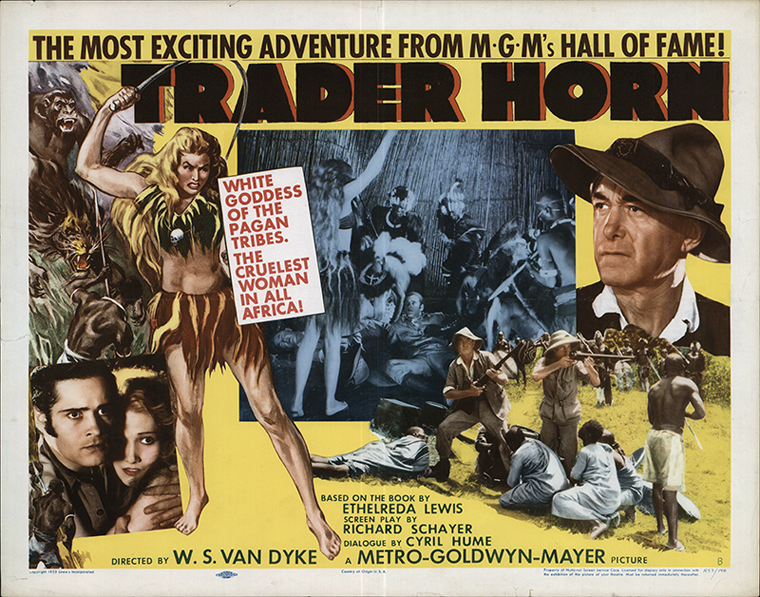
I didn’t sleep well the other night and woke up at 2:30 feeling hungry. Making my way to the kitchen, I prepared a small bowl of cereal, and sitting at the table clicked on the tiny kitchen TV.
Trader Horn, a 1931 black and white film starring Harry Carey (not a joke, really!) was playing on AMC, and while I gingerly spooned Heart Smart cereal into my mouth I nearly choked over what I watched. Watching AMC at 2:30 in the morning is a risky business.
Trader Horn was an “African Adventure” film about two white trader-adventurers flitting about the “dark continent” who happen to come into contact with a blond-haired white African Queen. Turns out she had been kidnapped from her missionary mother years earlier, and is portrayed as a particularly sadistic ruler who condemns the traders to death. In the end, her allegiance returns to her white race, and she and the two traders escape her tribe, finally saved by friendly pygmies. I’m not joking; this is really the basic plot, and Trader Horn was nominated for a Best Picture at the Academy Awards.
Below the melodrama and foolishness, one finds the explicit expression of anti-black racism in 1931, a mere 60 years or so after the Civil War. At this time the Ku Klux Klan was politically powerful, and segregation in the south was so well-entrenched as to be American apartheid. Hollywood, playing on the sensational and reflecting the attitudes of the times, includes dialog in Trader Horn such as “When the JuJu starts, every black devil in Africa will be out for blood!” and frequent references to African natives as “savages.” When some African porters are killed, they get nary a notice from the traders, whose response is simply “Best we leave quickly.” Upon their departure, they begin to shoot river crocodiles at random.
Ironically, I recently watched Avatar in 3D at the local theatre, and its similarities to Trader Horn are plentiful. The major difference, technology aside, is that the racism is viewed from the other side of the looking glass, reflecting the cultural shift that has taken place in Hollywood over 79 years. Rather than being portrayed as the hero, Avatar’s callous and arrogant Colonel Miles Quaritich (played by Stephen Lang) spews his racist remarks as a villain. Referring to the Na’vi people as “blue monkeys,” he becomes the counter-point to character Jake Sully who redeems himself by taking sides with the Na’vi in their struggle against domination by the rapacious and technologically superior Earthlings. Technology and weapons play a major role in both films; guns vs. spears in Trader Horn; gunships vs. arrows in Avatar. In the former they represent the successful dominance of a superior culture and its technology and in the latter the futile expression of a morally impoverished culture of greed.
In 1931 colonial powers controlled most of Africa, and the idea of exploiting the natural resources of the less developed world was explicitly accepted as sound economic and social policy. In the intervening years, Hollywood has changed its opinion, but the exploitation of the world’s resources continues to receive the governmental support of every powerful nation. To that extent, Trader Horn of 1931 remains an accurate portrayal of the cultural policies and attitudes underlying the unending environmental pillaging of our planet in 2010.